 W
WRügen is Germany's largest island. It is located off the Pomeranian coast in the Baltic Sea and belongs to the state of Mecklenburg-Western Pomerania.
 W
WThe battle of Bornholm was a naval battle between a superior Swedish and a smaller Danish-Dutch fleet that was fought 25–26 May 1676 as a part of the Scanian War. The objective for both sides was naval supremacy in the southern Baltic Sea. The Swedish commander Lorentz Creutz sought to destroy the allied fleet and then land reinforcements in Swedish Pomerania to relieve the Swedish forces in northern Germany. The aim of the Danish fleet under Niels Juel was to prevent this reinforcement without being destroyed by the superior numbers of the Swedish forces.
 W
WThe successful Landing on Groß Stresow by Prussian, Danish and Saxon troops took place on 15 November 1715 on the island of Rügen, Germany during the Great Northern War. The landing was followed with cavalry assaults from the Swedish defences on the island, commanded by Charles XII king of Sweden who despite the huge numerical disadvantage of - one up against five - chose to attack the fortified camp. The Swedes managed to get past the "Cheval de frise" and break through, but was then rapidly repulsed and routed after taking heavy casualties.
 W
WBergen auf Rügen Abbey was a monastery for Cistercian nuns established on the Baltic Sea island of Rügen. It lasted from the end of the 12th century to the early 16th century as a Roman-Catholic monastery and then, until 1945, as a Protestant aristocratic nunnery.
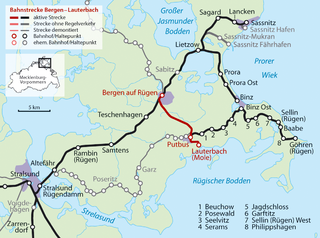 W
WThe Bergen auf Rügen–Lauterbach Mole railway is a single-track branch line on the German island of Rügen in the state of Mecklenburg-Vorpommern.
 W
WVfL Bergen is a German association football club from the city of Bergen auf Rügen, Mecklenburg-Vorpommern. The club was established in 1938 as Einheit Bergen and following World War II was reorganized as Sportgemeinschaft Rugia Bergen in Soviet-occupied East Germany.
 W
WDinosaur Land on the German island of Rügen was opened by Rüdiger Kunkel on 30 April 2008 on land that had belonged to the East German National People's Army (NVA). The site covers an area of 9.5 hectares in the municipality of Glowe and is not far from the villages of Spycker and Bobbin on Lake Spycker.
 W
WThe Dobberworth or Dubberworth is one of the largest prehistoric tumuli (Hügelgrab) in northern Germany, located on the isle of Rügen near Sagard. The Dubberworth is about 15 metres (49 ft) tall, and was made from an estimated 22,000 m3 of earth, making it the largest tumulus of Rügen. Archaeologists were not yet able to date the tumulus precisely, but assume it was used during the Bronze Age. The etymology of the name is also uncertain, "-worth" is linked to an old designation for an "elevated estate".
 W
WThe Ernst Moritz Arndt Tower stands on the top of the Rugard, the highest point of the central region of the German Baltic Sea island of Rügen. It is listed as a historic structure by the county of Rügen.
 W
WGarz Castle is a Slavic fort, of the type known as a burgwall, located southwest of the town of Garz on the German Baltic Sea island of Rügen. The earthworks have an oval shape, are about 200 metres long and 140 metres wide. There is an entrance roughly in the middle of the western side. Towards the lake of Garzer See to the south the ramparts are lower. It lies up to 15 metres higher than the town of Garz.
 W
WThe Gesundbrunnen Sagard was a spa and bathing institution in Sagard on the German Baltic Sea island of Rügen. Opened in 1795, it made Sagard the first bathing resort on Rügen and founded a healing spring establishment, that lasted until about 1830.
 W
WThe Goldbusch is a great dolmen, a type prehistoric grave site, that lies between Altensien and Moritzdorf on the German Baltic Sea island of Rügen. The megalithic tomb with Sprockhoff No. 508 was built between 3500 and 2800 B. C. in the New Stone Age as a megalithic site of the Funnelbeaker culture (TBK).
 W
WGranitz Hunting Lodge is located on the German island of Rügen in the vicinity of the seaside resort of Binz. With over 200,000 visitors per year it is the most popular castle or schloss in Mecklenburg-Vorpommern.
 W
WThe Great dolmen of Dwasieden, is a great dolmen in the borough of Sassnitz, on the Jasmund peninsula of Germany's largest island, Rügen. It was excavated in 1970 by Ewald Schuldt and is designated a Sprockhoff No. 472. The megalithic site of the Funnelbeaker culture (TBK) was constructed between 3500 and 2800 BC.
 W
WThe peninsula of Großer Werder lies southwest of the Hiddensee, west of the island of Bock and is joined to the peninsula of Zingst to the east. It belongs to the district of Vorpommern-Rügen in northeast Mecklenburg-Vorpommern in Germany.
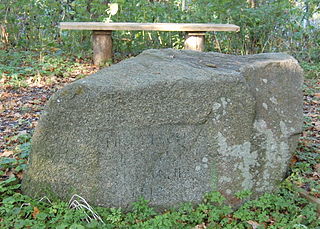 W
WThe Hessenlager or Hessian Camp is a former military encampment established by Hessian-Darmstadt troops during the French occupation near Göhren on the German island of Rügen.
 W
WThe invasion of Rügen of 22 to 24 September 1678 was a military operation in the Swedish-Brandenburg War, or Scanian War, that ended with the annexation of the Swedish-ruled island of Rügen by the Allies: Brandenburg-Prussia and Denmark.
 W
WThe naval Battle of Jasmund took place between elements of the Danish and Prussian navies on 17 March 1864 during the Second Schleswig War. The action took place east of the Jasmund peninsula on the Prussian island of Rügen, during a Prussian attempt to weaken the Danish blockade in the Baltic Sea. The Prussian squadron, commanded by Eduard von Jachmann, sortied with a screw frigate, a screw corvette, a paddle steamer, and six gunboats to attack the Danish squadron blockading the eastern Prussian coast. The Danish force was commanded by Edvard van Dockum, and it consisted of one screw frigate, one ship of the line, and two steam corvettes. In an action lasting two hours, the superior Danish squadron forced the Prussians to withdraw, both sides suffering damage and light casualties. The Danish victory was compounded by the arrival of further warships after the battle, which cemented the blockade. The outcome of the battle, and the naval war in the Baltic as a whole, was irrelevant to the outcome of the war, however, as the Prussian and Austrian armies decisively defeated the Danes on land, forcing them to surrender.
 W
WKrake was a Dutch sailing ship with the identifier ZK 14. It was bought by the German progressive pedagogue, bard and writer Martin Luserke. The former fishery vessel was deployed as his floating poet's workshop. It cruised the shallow coastal regions of The Netherlands, (Germany), Denmark, Southern Norway and Southern Sweden as well as channels and rivers between North Sea and Baltic Sea. In harbours it was visited by a larger quantity of mostly younger people who attended readings and taletellings. Krake became very well-known during 1934 and 1938 and still is a topic in German literature, scientific literature, local museums, libraries, archives, encyclopaedias, and lectures. One of its later well-known visitors was German pilot Beate Uhse.
 W
WKreis Bergen was a Kreis on the island of Rügen in the district of Bezirk Rostock in East Germany from 1952 to 1955.
 W
WKreis Putbus was a Kreis on the island of Rügen in the district of Bezirk Rostock in East Germany from 1952 to 1955.
 W
WLancken-Granitz is a municipality in the Vorpommern-Rügen district, in Mecklenburg-Vorpommern, Germany. Near the villages of Lancken and Burtevitz are several megalith tombs from the Neolithic.
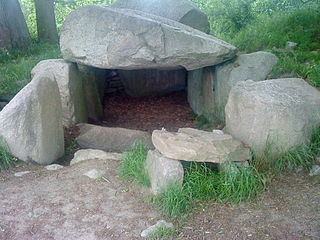 W
WThe Lancken-Granitz dolmens are a group of seven megalith tombs in the Lancken-Granitz municipality on Rügen, northern Germany. Erected during the middle Neolithic, when they were used by the Funnelbeaker culture, at least some were in use until the early Bronze Age. Three of them are encircled by solitary rocks forming either rectangles or a stone circle, one has a solitary "guardian stone" on its eastern side.
 W
WThe village church of Landow is the Evangelical parish church of the parish of Rambin in the south of the German island of Rügen. It is located in the village of Landow in the municipality of Dreschvitz.
 W
WLietzow and Binz railway is a single track, electrified branch line on the German Baltic Sea island of Rügen in the state of Mecklenburg-Vorpommern. It mainly used by local and long-distance passenger services.
 W
WThe Mönchgut Coastal Fishing Museum in the German Baltic Sea resort of Baabe shows the methods of production used by fishermen living on Mönchgut, who were influential boat builders. The museum opened on 2 June 2001.
 W
WMönchgut-Granitz is an Amt in the district of Vorpommern-Rügen, in Mecklenburg-Vorpommern, Germany. The seat of the Amt is in Baabe.
 W
WThe Oldtimer Museum Rügen is a German railway museum based on the Baltic Sea island resort of Rügen in the state of Mecklenburg-Western Pomerania, Germany. It was established in 1994 and is housed in the museum section of the Nazi-built Kraft durch Freude building complex at Prora which is a protected monument.
 W
WThe Colossus of Prora, commonly known as simply "Prora", is a building complex in the municipality of Binz on the island of Rügen, Germany. It was built by Nazi Germany between 1936 and 1939 as part of the Strength Through Joy project. It consisted of eight identical buildings and was 4.5 km (2.8 mi) in length parallel to the beach, with the surviving structures stretching 3.0 km (1.9 mi).
 W
WThe Prussia Columns are two monuments, over 15 metres (49 ft) high, that were erected in the years 1854 and 1855 by order of the Prussian king, Frederick William IV on the southeast coast of the German island of Rügen near Neukamp and Groß Stresow. Both villages are today part of the municipality of Putbus.
 W
WRügen Airport, also known as Bergen Airfield or Güttin Airfield, is the only airfield on the German Baltic Sea island of Rügen. The airfield lies in the municipality of Dreschvitz in its subdistrict of Güttin, about 8 kilometres south of the town of Bergen next to the B 96 federal road. Use of the tarmac runway is restricted to aeroplanes with a maximum weight of 5/7 tonnes. It can be lit for night-time operations.
 W
WSassnitz Wildlife Park is a wildlife park in the borough of Sassnitz on the German Baltic Sea island of Rügen.
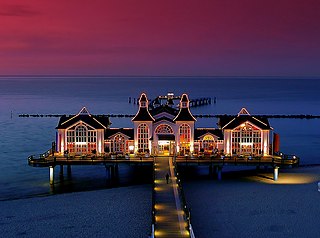 W
WSellin Pier is a pier in the Baltic seaside resort of Sellin on the German island of Rügen. The pier has a restaurant near the beach over the water and has a diving gondola (Tauchgondel).
 W
WThe Spyker Castle and estate lie on the territory of the municipality of Glowe in the district of Vorpommern-Rügen in the German state of Mecklenburg-Vorpommern. Spycker Castle is the oldest profane structure on the Baltic Sea island of Rügen.
 W
WThe Störtebeker Festival is an yearly open-air theatre festival in Germany. It is based on stories around the medieval German privateer Klaus Störtebeker and his Victual Brothers, who later turned to pirates.
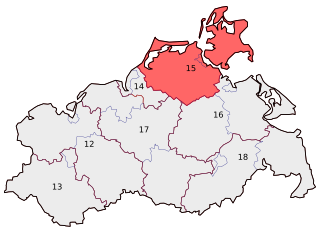 W
WStralsund – Nordvorpommern – Rügen was an electoral constituency represented in the German Bundestag from 1990 to 2013. Part of the state of Mecklenburg-Vorpommern, the constituency elected one representative under the mixed member proportional representation (MMP) system. Under the current constituency numbering system, it was designated as constituency 15. The constituency was abolished as part of the 2012 federal boundary review, which saw the state of Mecklenburg-Vorpommern lose one of its 18 geographic constituencies as a result of population change. It was largely replaced with the Vorpommern-Rügen – Vorpommern-Greifswald I constituency, which took its district number of 15.
 W
WStralsund–Sassnitz railway is a railway line, most of which is located on the German island of Rügen and which is its most important railway. The line is the northernmost German section of the route from Berlin to Stockholm.
 W
WStrelasund Crossing refers to the two bridge links to the German island of Rügen (Rugia) over the Strelasund to the West Pomeranian mainland near Stralsund: the Rügen Bridge or Rugia Bridge and the Rugia Causeway (lang|de|Rügendamm}}).
 W
WVorpommern-Rügen – Vorpommern-Greifswald I is an electoral constituency represented in the Bundestag. It elects one member via first-past-the-post voting. Under the current constituency numbering system, it is designated as constituency 15. It is located in northeast Mecklenburg-Vorpommern, comprising the Vorpommern-Rügen district and a small part of the Vorpommern-Greifswald district.